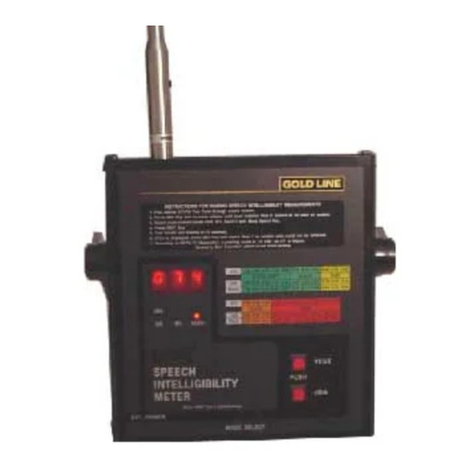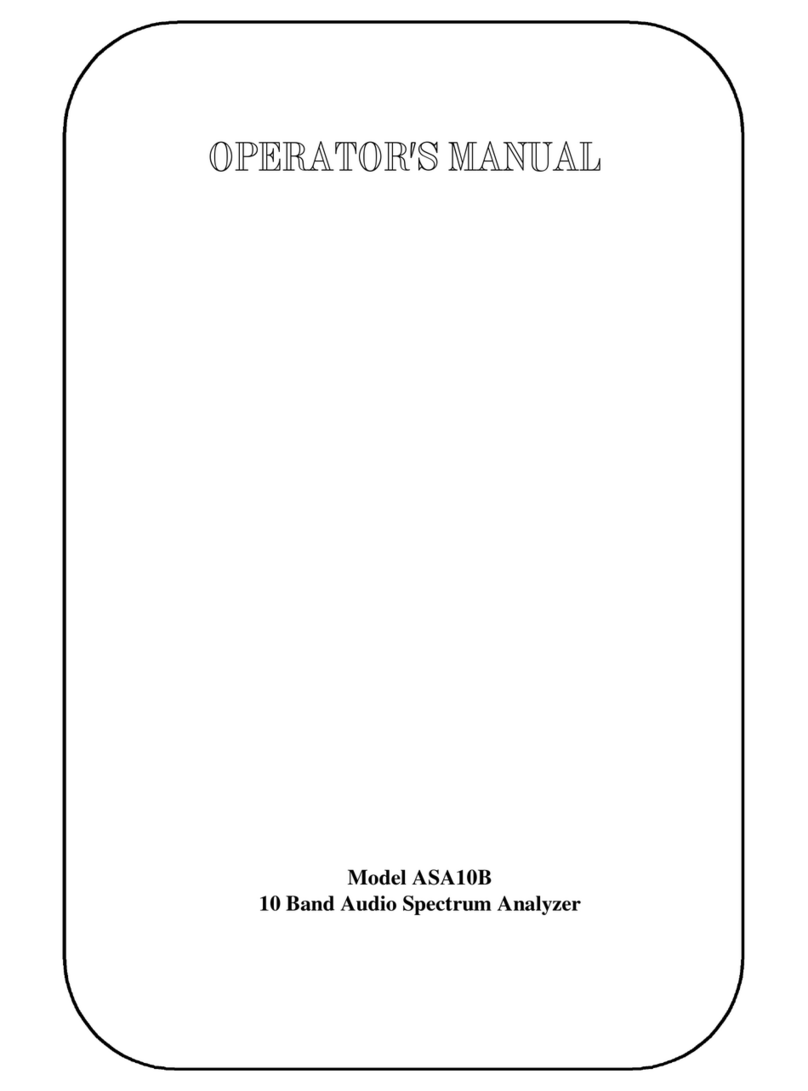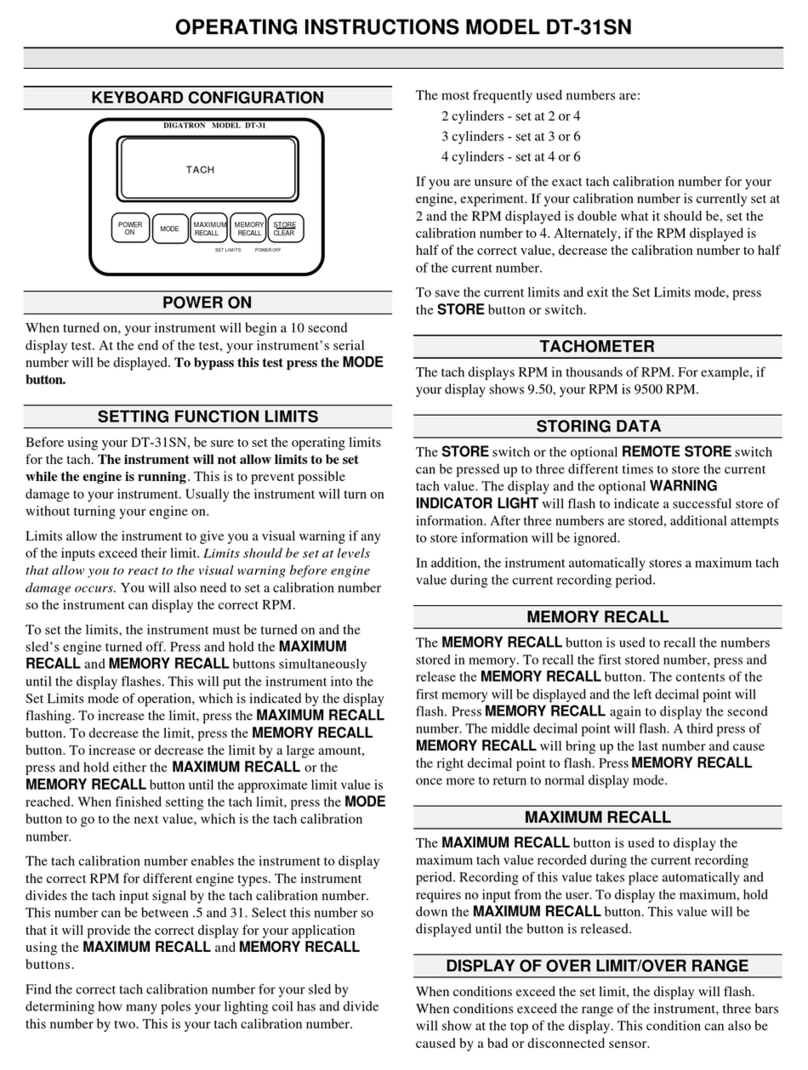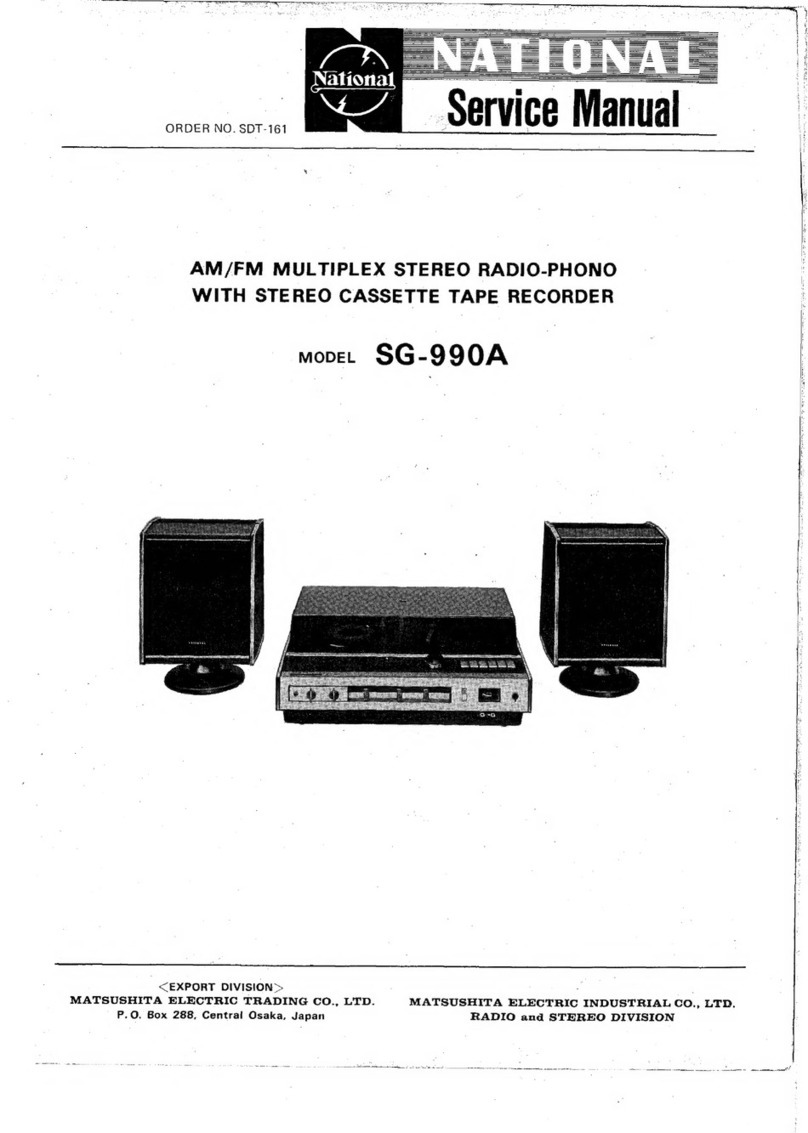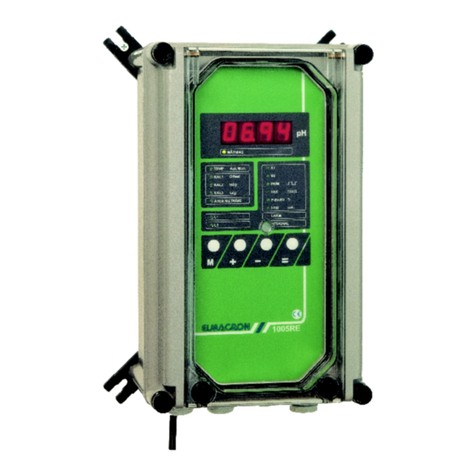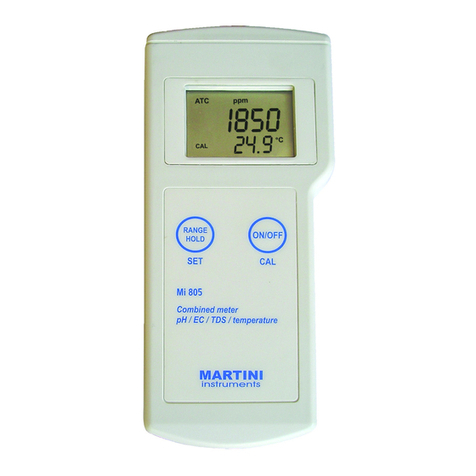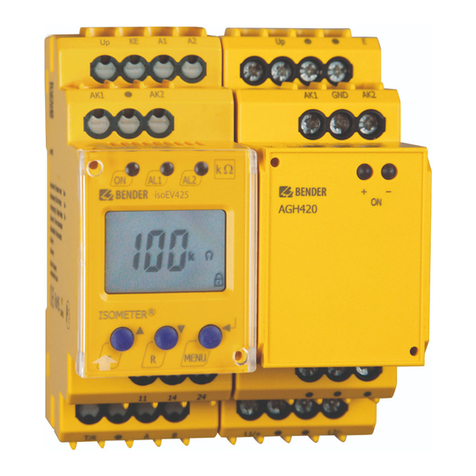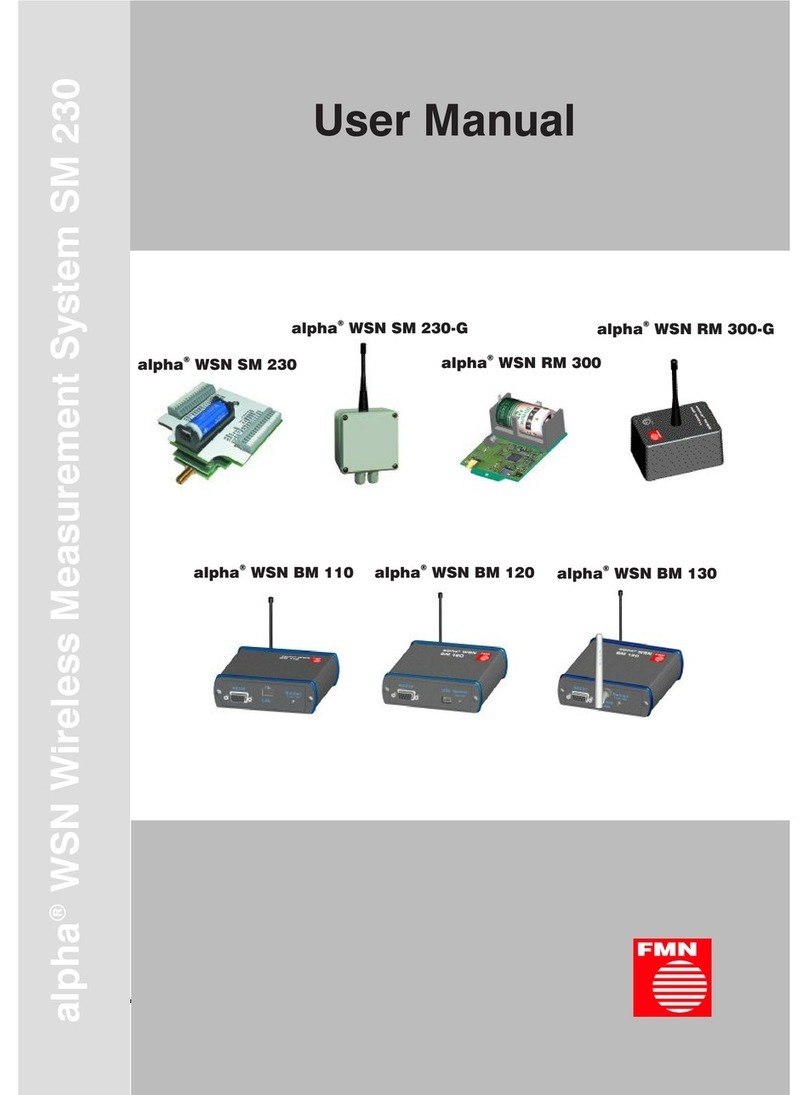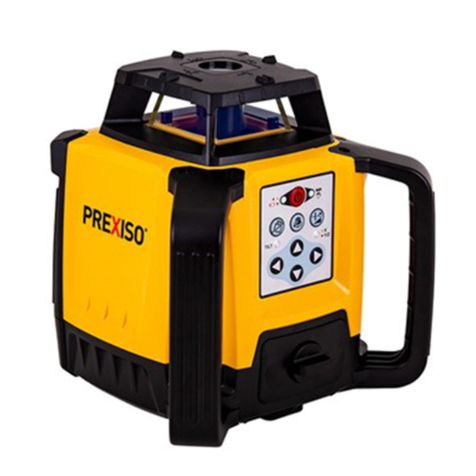Goldline 30MP User manual

OPERATORS MANUAL
Model 30MP
30 Band 1/3 Octave
Microprocessor Controlled RTA

1
GENERAL:
The Gold Line 30MP is a complete 1/3 octave battery operated portable audio spectrum analyzer complete with
separate microphone and 6 non-volatile memories. It is also an accurate dB meter and will read Sound Pressure
Levels in either Flat, "A" or "C" weighting.
Microphone: Measurement microphone, Model MK8A, is provided with the 30MP. This microphone is internally
equalized to be flat ±1.5dB from 20Hz - 20kHz. It can be attached directly or with any standard XLR audio cable.
The MK8A is calibrated for proper sensitivity for accurate SPL measurements; other microphones will give
incorrect readings or not work at all.
Pink Noise: The 30MP is used in conjunction with a pink noise generator such as the Gold Line PN2 or PN3B.
Pink noise is a sound that has equal amount of energy per octave of bandwidth. Pink noise is the basic reference for
all measurements and adjustments to a system. Pink noise normally has a flatness of ±2dB with random waves that
may be higher or lower.
Power: The 30MP is powered by eight (8) AA alkaline, nicad or the longer lasting 1.5 volt nickel metal hydride
(NiMH) batteries. To install the batteries, remove the cover plate on the rear of the unit by loosening the four
retaining screws. Important! Set the battery selector switch to either Alkaline or Nicad to match your type of
battery. Use the Nicad setting if you are using NiMH batteries. Do not use carbon-zinc batteries. At a nominal 12
volts, the current drain is 200 mA with an LED lit in each filter band. An external power supply such as the Gold
Line BE1 battery eliminator can also be used to power the unit via a 3.5mm jack labeled “EXT” on the side of the
case just below the ON/OFF power switch. Alkaline batteries are disconnected when a battery eliminator is plugged
in. Nicads or nickel metal hydride batteries are kept in circuit and can be recharged in the case. Do not attempt to
charge Alkaline batteries!
The Display: The display consists of a matrix of 300 LED's: a column for each of 30 filter bands on standard ISO
frequencies with 10 LED's in each column. 1dB, 2dB or 3dB scaling can be selected. (See Scale) The 1dB scale
markings are located at the left of the display, the 2dB in the center and the 3dB at the right of the display.
Microphone Input: The Microphone input is via a 3 pin XLR connector (Balanced) and 12 volt phantom
powering is provided.
Line Input: The Line Input jack accepts a standard ¼" phone plug and has an impedance of 10kΩ. The
microphone is automatically disconnected when a plug is inserted into the Line Input jack.
A handy calibration check can be made by plugging pink noise into the Line Input jack. Use the SLOW setting and
set the sensitivity to center the resulting flat line. (Pink noise normally has a flatness of ±2dB with random waves
that may be higher or lower.)
ANALYZER CONTROLS:
Scale: The [Scale] button allows you select from a 1dB, 2dB or 3dB per step display. The scale indicator LEDs are
located under the main display matrix.
Level ⇑⇑, Level ⇓⇓:The [Level] buttons are used to increase or decrease the unit sensitivity (change the reference
level). If the unit is in a Scale of 1dB per step the unit will increase or decrease in 1dB steps. To see the current “0”
line Reference Level, press and hold either the ⇑⇑ or ⇓⇓button for three (3) seconds. The reference level will appear
on the 300 LED Matrix display.
The (reference) LEVEL is controlled by single keystrokes of either the UP LEVEL or the DOWN LEVEL (Arrow
Keys). The increase/decrease increment is determined by the Scale setting. Releasing the [Level] button will return
the display to the prior mode (either RTA or SPL).
Weight: The 30MP has four SPL functions selected with the WEIGHT button. To activate the SPL readings press
the [Weight] button. The SPL will appear on the 300 LED display starting with SPL Flat and will step through
each function each time the button is pushed. By pressing the [Weight] button a fifth time, the unit will exit the
SPL mode and return to the RTA frequency response mode.

2
1. ”FLAT” is indicated in dB without an alpha character following the number. FLAT represents no shaping of
the response curve.
2. "A" Weight shows the overall level in dBa. The letter A follows the number. (Often used when making speech
interference measurements and to comply with government noise regulations to protect against hearing loss.)
3. "C" Weight shows the overall level in dBc. The letter C follows the number. (Often used for cinema, home
theater, studio and environmental noise measurements.)
4. “T” Weight - The letter T follows the number. The dBT “theater mode” utilizes C weighting, but with the
gain stages fixed for use at the 75dBc levels specified for Home Theater Reference level calibration.
Decay: The [Decay] button provides three functions; FAST, MEDIUM and SLOW. In FAST, a response at 0dB
will fall to -10dB in 2 seconds at 25Hz and to 0.5 seconds or less at 500Hz and above. In SLOW, the same
response will fall 10dB in about 20 seconds at 25Hz and to 6 seconds at 500Hz and above. The response to a
sudden increase in level, the attack time, is short in both FAST and SLOW. When monitoring music or speech use
FAST to see rapid level changes. When using pink noise use SLOW for a more stable display. Press the Memory
Mode button to freeze the display.
Mode: The [Mode] button toggles between Real Time Analysis and Memory mode. Memory one will be
automatically displayed when entering Memory mode. The Green Memory LED is lit when in Memory mode.
Select: The [Select] button will step through and display the memories when in either RTA or memory mode. The
corresponding Red Memory LED will light.
Store: Pressing the [Store] button will write the current display to the next memory.
ANALYZER FUNCTIONS:
Default Settings at Power-Up: The 30MP powers up in the RTA Mode, at a Reference Level of 65dB, a Scale of
3dB per step and Decay set to FAST.
Firmware Version Number: Press and hold the [Weight] button.
Battery Status: To activate the battery STATUS indicator, press and hold the [Decay] button on the front panel. A
battery icon will indicate the amount of charge in the batteries or if the batteries are in the process of recharging.
Nicads can be recharged in 8 to 16 hours.
Line Level Calculations: An estimate of Audio Line levels in dBu from –40dBu to +18dBu can be obtained by
plugging an unbalanced line level into the Line Level Input on the 30MP. 0dBu displays as 118dB when in the flat
weighted SPL scale display mode, and as electrical line levels rise or drop in dBu, the scaling as displayed on the
30MP remains linear. To calculate a dBu level using this method, use the following conversion. 0dBu read as
118dB SPL, and accordingly +4dBu would display as 118+4 = 122dB on the SPL Scale. -10dBu would read as
118-10 = 108dB on the SPL scale. Measurement down to –40dBu can be made in this manner. It may be difficult
to read levels that are rapidly changing as the unit takes time to change gain stages. Accordingly, levels are best set
with a sine wave running through the system.
MEMORY FUNCTIONS:
The 30MP has six non-volatile memories. Memories are retained when the 30MP is powered down. You can
overwrite memories as often as you wish. The 30MP will write to the next available memory. When all six
memories have been used, it will over-write memories starting with memory one. Unused memories are shown by
lighting the two top rows.
To Store A Memory: Press [Store] to capture the screen display and to change from RTA to MEMORY. The
captured display will be written to the next memory. Once all six memories are full, the unit will over-write
memories beginning at memory one. Press [Select] to step through the memories starting with memory one. Press
[Mode] to return to RTA.
To View A Memory: Press [Mode] to enter MEMORY mode. Press [Select] to step through the stored memories.
Unused memories are shown by lighting the two top rows. Press [Mode] to return to RTA Mode. When entering

3
Memory Mode for the first time after power-up, the unit will display memory one. After viewing and/or storing
memories, the unit will return to the last memory displayed until it is powered down.
RS232 Output (Optional): An RS232 port can be ordered to transfer stored data to a PC. Software is available for
printed reports. Information stored in the 30MP non volatile memories can be downloaded to your PC to capture
both the frequency response and the Sound Pressure Level.
ELIMINATING FEEDBACK:
Gold Line real time audio analyzers are the most effective way to prevent feedback.
1. Feed pink noise into the line input of the sound system and set the volume for a moderate level from the
speakers.
2. Turn up the gain on the main microphone input until feedback starts. Do not allow feedback to become overly
loud.
3. Once feedback is heard, use the analyzer, look for one band to be peaking above the others. The single frequency
which is much higher than the adjoining frequencies is the one which is causing the feedback.
4. Adjust the equalizer to put in just enough cut in that band to stop the feedback. If you are using a parametric
equalizer, select the minimum bandwidth to eliminate the feedback.
5. Continue to increase volume and cut where indicated, until the system gain is ideally 6dB above the levels where
the system will typically be utilized.
6. As a general rule, when feedback has occurred in 3 or more bands the practical limit of feedback control with
the minimum effect on the overall sound has been reached.
7. Open other microphones that will be on at the same time and change settings as needed for best performance.
The more microphones that are open at any one time, the more prone to feedback a system will become.
8. As a final adjustment, performers should stand at the microphones in their normal positions, as the proximity to
the microphones can cause some changes in feedback modes.
GENERAL PROCEDURES FOR EQUALIZATION:
1. Turn off the sound system before making connections and put all Equalizer controls to flat. Turn down the
volume at the pre-amp or mixing board before proceeding to next step.
2. Connect a pink noise source to a line level input for one channel only. Turn on the system.
3. Advance the volume to a moderate level loud enough to overcome ambient noise. Do not overdrive. For Pro-
Audio or Cinema systems, around 80dB Flat SPL is a typical level for the pink noise while adjusting equalization.
Some people may wish to use earplugs if you will be making prolonged tests.
4. Set the 30MP [DECAY] to SLOW. Start in 3dB Scale, and then go to 2 or 1dB if you need more detail about the
frequency response.
5. Place the microphone in the center of the listening area.
6. Set the SENSITIVITY of the 30MP to put the majority of the response curve near 0dB. The microphone is an
omni-directional pattern, but most users generally orient the front of the microphone towards the loudspeaker
being measured. Make a note of the Frequency response, Record the levels or store them in memory.
7. In the lower frequencies there can be great deviations from flat caused by speaker and room characteristics.
Usually it is impossible to make changes in room shape and size but speaker positions can be changed to minimize
energizing these “room modes”.
8. If inside, try different speaker positions along and up and down the back wall. Also try varying distances from
the wall. Each response can be store in memory for later comparison. Move the microphone around the room to see
where differences occur as room modes will be spaced at intervals equal to their wavelengths.
9. The high mid-frequency response of the system will be greatly effected by the speaker's angular position; how it
is aimed pointed relative to the room and listener positions. Make adjustments for maximum output in the highest
frequencies.
10. After making changes, move around the room while observing the analyzer's display taking note of changes in
response. Equalization should provide for smooth frequency response across the listening area, rather than for just
a single place in the room.
11. Adjust the system's equalizers, or tone and tweeter controls, etc., to obtain the flattest response.
Do not try to boost out deep notches that might be caused by a cancellation or a poorly selected crossover point.
Too much boost can overdrive the entire system. Every time you add 3dB of boost with an equalizer or gain

4
control, you effectively double the power sent to the system at that frequency. Use boost with great care so as to
avoid overstressing amplifiers or loudspeakers.
Use cut to reduce problem areas. Try to use tone controls or other broad shelving type EQs to reduce the extent of
narrow-band EQ. If using a parametric EQ at mid or high frequencies, a wider filter (lower Q) is sometimes better
than using multiple narrow filters to correct problems in adjoining frequency bands.
In general few people attempt to boost systems above 8kHz, and many audio engineers allow high frequencies to
roll off (house curve).
Sound systems that are used exclusively for speech (not music) are often equalized to only reproduce flat response
within the range of human speech, 125Hz to 8kHz, and a cross over or cut filters are used to roll off energy above
and below this “speech range”.
12. Recheck the system response with the analyzer and trim adjustments for the best compromises over all bands.
13. Repeat the above steps for other channels.
14. With all channels equally driven, you may wish to do a final adjustment to low frequency EQ for flat response
in the listening area up to 250Hz (modal region).
15. The “liveliness” of a room will have an effect primarily in the medium/high frequency areas. Rugs, furniture,
drapes and people absorb sound which could cause a need a small amount of boost in the medium/high frequencies
if the room is equalized when empty.
16. CAUTION- DO NOT use extreme amounts of bass boost with small speakers. They could be destroyed. Try to
find the best speaker to wall distance to minimize the need for boost.
This equipment has been tested and found to comply with the limits for a Class B digital device, pursuant to part
15 of the FCC Rules. These limits are designed to provide reasonable protection against harmful interference in a
residential installation. This equipment generates, uses and can radiate radio frequency energy and, if not installed
and used in accordance with the instructions, may cause harmful interference to radio communications. However,
there is no guarantee that interference will not occur in a particular installation. If this equipment does cause
harmful interference to radio or television reception, which can be determined by turning the equipment off and
on, the user is encouraged to try to correct the interference by one or more of the following measures:
-Reorient or relocate the receiving antenna.
-Increase the separation between the equipment and receiver.
-Connect the equipment into an outlet on a circuit different from that to which the receiver is connected.
-Consult the dealer or an experienced radio/TV technician for help.

5
SPECIFICATIONS
MEASUREMENT RANGE: Microphone input: 62dB - 123dB SPL
Line input: -70dBu to +18dBu
(0.25mV - 6.15V rms)
DISPLAY: 30 Bands on ISO centers, 10dB to 30dB window in 1dB, 2dB or
3dB steps.
INPUTS: Microphone: XLR 3 pin receptacle with phantom power.
Line: Unbalanced ¼" phone jack. 10kΩ impedance.
OUTPUTS: Standard - None
Optional RS232 available. 9 Pin DSub Connector.
MICROPHONE: 600Ω omnidirectional electret condenser. Model MK8A.
CENTER FREQUENCIES: ISO 1/3 octave between 25Hz - 20kHz
CENTER FREQUENCY ACCURACY: Typically ±3%
MEMORIES: Six non-volatile. (Retained when 30MP is powered down).
FILTERS: ANSI Class II
RELATIVE FLATNESS CHANNEL TO CHANNEL: ±1.0dB
WEIGHTING: IEC A, C and FLAT plus Home Theatre T.
DECAY RATE (@ 500Hz): SLOW 4.3dB/s, MEDIUM 8.7dB/s, FAST 34.7dB/s.
APPROVALS: Emissions: - EN 55022 B - FCC Class B
Immunity: - EN 55024 B
POWER REQUIREMENTS: Batteries - Eight AA alkaline, nicad or NiMH (Nickel Metal Hydride).
External - 12Vdc @ 500mA via 3.5mm jack
Internal switch MUST be set to NICAD when recharging NICAD or NiMH batteries.
SIZE (W x H x D); WEIGHT: 10.750” x 7.00” x 1.75”; 2 lbs.
CASE MATERIAL: Powder Coat Aluminum
WARRANTY and Factory Service
GOLD LINE products are proudly made in the USA and are covered by a one year limited warranty. For details of this
warranty, consult the enclosed warranty registration card or your local dealer.
GOLD LINE Customer Service will help you get the most from your new analyzer. For answers to questions regarding use of
the unit, or for information not covered in this manual, please write us. If you are experiencing difficulties with your analyzer,
please consult your dealer regarding factory service. If factory service is needed, you may call or fax us between 9:00am and
4:30pm US Eastern Time for instructions and a return authorization.
Enter your serial#______________date of purchase______________ m_30mp_4g01.doc
Box 500 West Redding, CT. 06896 203-938-2588 phone - 203-938-8740 fax
http://www.gold-line.com Email - [email protected]
Table of contents
Other Goldline Measuring Instrument manuals
Popular Measuring Instrument manuals by other brands

PURE
PURE Avalon 300R Connect manual
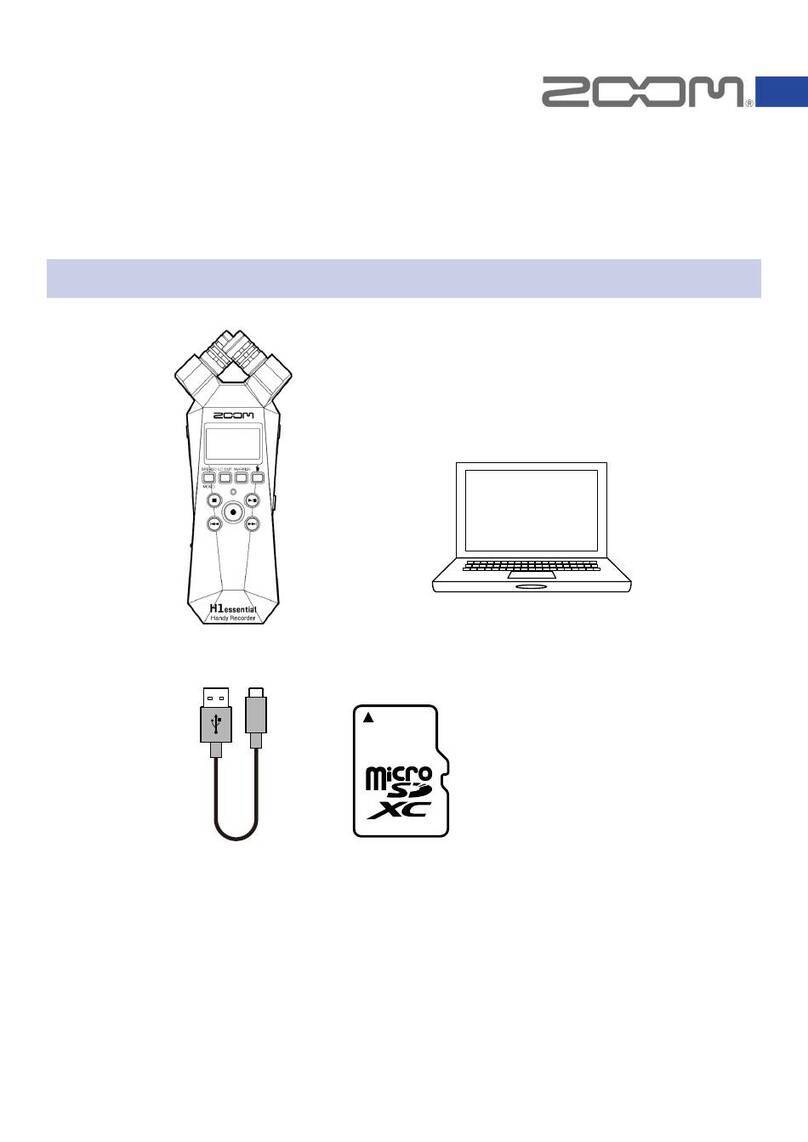
Zoom
Zoom H1essential Firmware update guide
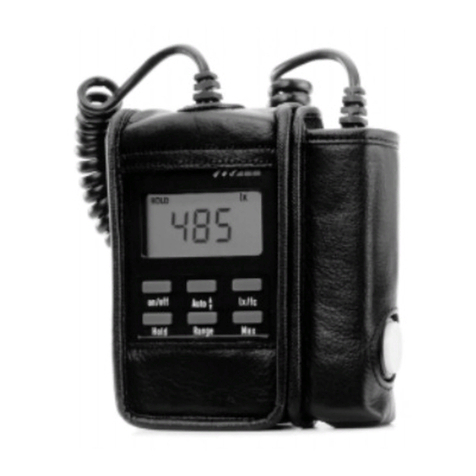
Gossen MetraWatt
Gossen MetraWatt MAVOLUX 5032C operating instructions

ANDERSON-NEGELE
ANDERSON-NEGELE IZMSA operating manual
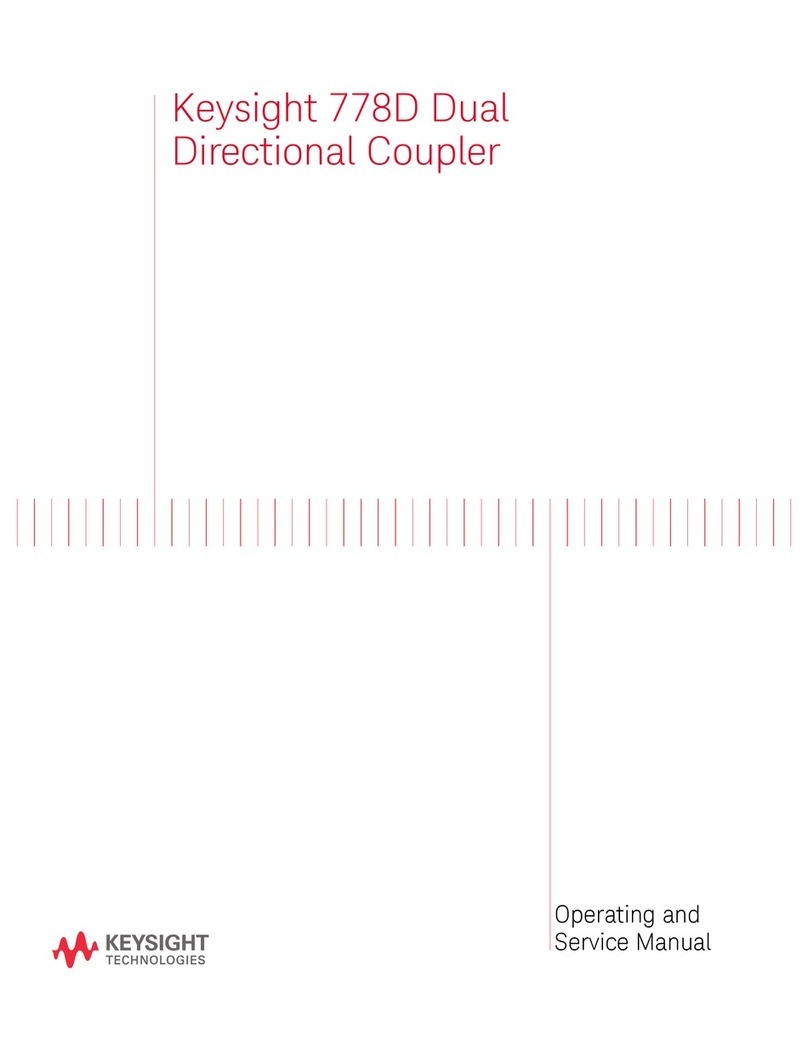
Keysight
Keysight 778D Operating and service manual
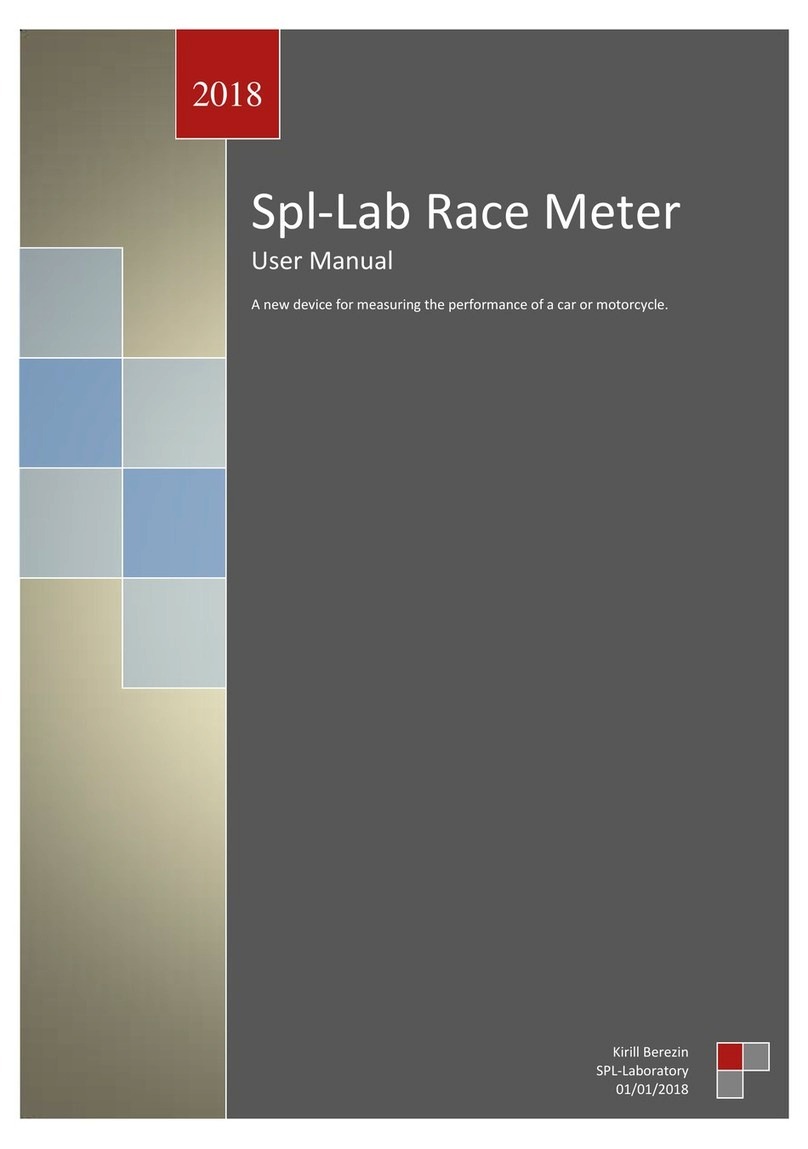
SPL-Laboratory
SPL-Laboratory Race Meter 2018 user manual
